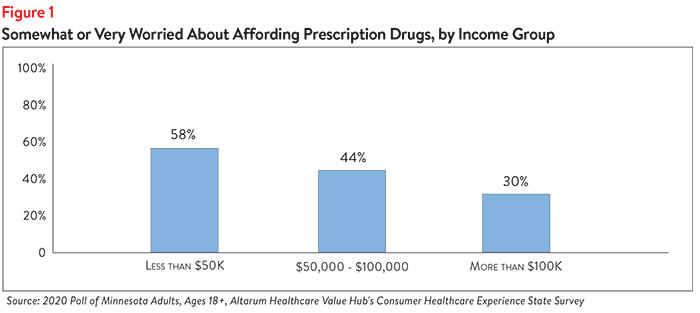Minnesota Residents Worried about High Drug Costs–Support a Range of Government Solutions
According to a survey of 1,077 Minnesota adults, conducted from Oct. 30, 2020 to Nov. 27, 2020, residents are concerned about prescription drug costs and express a strong desire to enact solutions.
Almost half of all survey respondents (45%) reported being either “somewhat worried” or “very worried” about affording the cost of prescription drugs. Worry varied significantly by income group, with residents in households making less than $50,000 per year being almost twice as worried as those in households making more than $100,000 per year (see Figure 1).

In addition to being worried about prescription drug affordability in the future, many Minnesota residents experienced hardship in the prior 12 months due to the cost of prescription drugs. Indeed, cost concerns led 1 in 5 Minnesota adults (21%) to not fill a prescription, cut pills in half or skip a dose of medicine (see Figure 2).

Regions within Minnesota show significant variation with respect to drug affordability issues (see Table 1). Twenty percent of adults in the Twin Cities Metro area had difficulty affording prescription drugs in the prior 12 months, while adults in Southern Minnesota fared worse, at 25%.

These hardships have a disproportionate impact on lower income households. As Figure 3 shows, households making less than $50,000 per year are three times as likely to have rationed their prescription medicines (by not filling a prescription, cutting pills in half or skipping a dose of medicine) as households making more than $100,000 per year. Moreover, these hardships are alarmingly prevalent in middle income households.

When given more than 20 options, the option cited most frequently as being a “major reason” for high healthcare costs was “drug companies charging too much money:”
- 70%—Drug companies charging too much money
- 61%—Insurance companies charging too much money
- 56%—Hospitals charging too much money
When it comes to tackling high drug costs, respondents endorsed a number of strategies:
- 89%—Set standard prices for drugs to make them affordable
- 88%—Authorize the Attorney General to take legal action to prevent price gouging or unfair prescription drug price hikes
- 88%—Ensure the cost of widely needed vaccines are affordable for all
- 87%—Require drug companies to provide advanced notice of price increases and information to justify those increases
- 87%—Create a Prescription Drug Affordability Board to examine the evidence and establish acceptable costs for drugs
- 87%—Prohibit drug companies from charging more in the U.S. than abroad
While Minnesota residents are united in calling for the government to address high drug costs, they also see a role for themselves:
- 78% would switch from a brand name to a less expensive generic if given the option
- 49% have tried to find out the cost of a drug beforehand
In light of these prescription drug cost concerns—as well as concerns about high healthcare costs generally—it is not surprising that Minnesota adults are extremely dissatisfied with the health system:
- Just 34% agreed or strongly agreed that “we have a great healthcare system in the U.S.,”
- While 65% agreed or strongly agreed that “the system needs to change.”
There is remarkably high support for government action on drug costs regardless of the respondents’ political affiliation (see Table 2).

Comparing 2020 Results to the 2019 CHES Survey
We caution readers against drawing strong conclusions about changes observed between the 2019 and 2020 CHES Surveys. While the findings from the two surveys are remarkably consistent, small differences in the weighting approach and in the instrument itself indicate that direct comparisons should not be made. For more information on the Minnesota state surveys, go to www.healthcarevaluehub.org/minnesota-state-survey
Methodology
Altarum’s Consumer Healthcare Experience State Survey (CHESS) is designed to elicit respondents’ unbiased views on a wide range of health system issues, including confidence using the health system, financial burden and views on fixes that might be needed.
The survey used a web panel from Dynata with a demographically balanced sample of approximately 1,000 respondents who live in Minnesota. The survey was conducted only in English and Spanish and was restricted to adults ages 18 and older. Respondents who finished the survey in less than half the median time were excluded from the final sample, leaving 1,077 cases for analysis. After those exclusions, the demographic composition of respondents was as follows, although not all demographic information has complete response rates:








